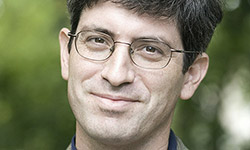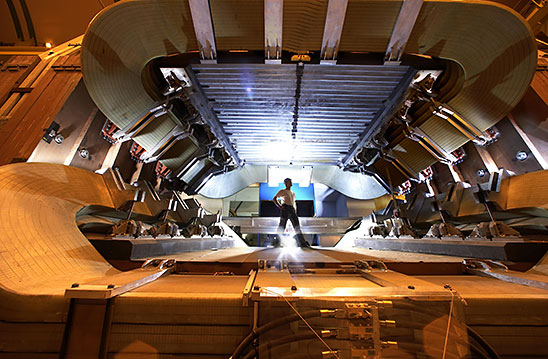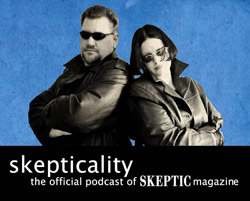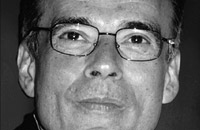- H1N1 lecture on DVD: The Evolution of a Deadly Virus
- feature article: Will Physicists Destroy the World?
- feature rebuttal: Physicists Will Not Destroy the World!
- Skepticality: Absinthe: The Green Fairy Revealed
- latest from Michael Shermer: Staring at Men Who Stare at Goats
- lecture reminder: Bright-Sided, with Barbara Ehrenreich
H1N1 lecture on DVD
The Evolution of a Deadly Virus.
What Diseases Tell Us About Evolution

Carl Zimmer
a recent lecture at Caltech
by Carl Zimmer
Carl Zimmer, an award-winning science writer for the New York Times, Discover magazine, Scientific American, and others takes readers on a frightening tour of the H1N1 flu virus, how it evolved, and what deadly diseases tell us about how evolution works. Reviewing the history of influenza going back over a century, including a complete analysis of the 1918 influenza outbreak that killed tens of millions of people…
In this week’s eSkeptic, Lloyd B. Lueptow asserts that the Large Hadron Collider experiments should be delayed or stopped while the risk/cost-benefit equation is sorted out in debates the public can comprehend. The only acceptable risk is zero when the cost is the possible destruction of planet Earth. This piece is followed with a rebuttal by Dr. Lawrence Krauss.
Dr. Lloyd B. Lueptow is an emeritus professor of Sociology, University of Akron. His research focused on gender differences, conducting two major longitudinal studies of 5600 and 4000 respondents over some 30 years, concluding that the persisting gender differences in the face of substantial social change were more likely due to evolutionary than to sociocultural factors. Since retirement he has continued to study the literature on evolution and human behavior. In the past year he has focused on web postings, articles and books on the issue of catastrophic possibilities at particle colliders, in an attempt to determine where the reality lay.

a magnet in one of CERN’s large hadron colliders known as LHCb where b stands for “beauty”
(credit: Peter Ginter, LHCb Aimant 2008)
Will Physicists Destroy the World?
The Large Hadron Collider
and the Threats of Catastrophe
by Lloyd B. Lueptow
Earth-threatening catastrophe scenarios are once again in the news. Even if you are not worried about the Mayan calendar running out in 2012, or being “left behind” in a biblical Armageddon, there are some scientists concerned about the unanticipated outcomes of experiments such as those at the Large Hadron Collider (LHC). Specifically, could this ultimate atom smasher create miniature black holes, strangelets, or vacuum instabilities that could literally destroy the planet? What are the odds of these scenarios unfolding, and are they worth worrying about?
Our world has been, and continues to be shaped by the remarkable and accelerating advances of science and technology. It is also a world now aware of potential catastrophes that could destroy humanity, or even the Earth. Nearly all of them can be prevented with planning, and appropriate social and political responses. In his analysis in Futures magazine, Mark Leggett of the Key Center for Ethics, Law, Justice and Government at Griffith University lists 15 such catastrophic risks.1 Among them are asteroid impacts, global warming, nuclear war, and scientific accidents at particle accelerators like the LHC that the European Organization for Nuclear Research (CERN) is soon to reactivate.
Concerns about the collider experiments focus on the following potential threats: strange matter (strangelets), miniature black holes (mBHs), and vacuum instability of the universe. Let’s examine these individually.
Miniature Black Holes
Skeptic lecture DVDs
by Michio Kaku

Physics of the Impossible
Michio Kaku explores to what extent technologies and devices deemed impossible today might become commonplace in the future.
Parallel Worlds
Kaku presents a fascinating tour of cosmology, including M-Thoery, inflationary universe theory, parallel universes, creation, black holes, and superstrings.
Black holes are the only one of the three phenomena that have actually been observed. Black Holes are visually dramatic as they attract matter and light into the core at speeds and energy levels that preclude the escape of anything, including light. However, scientists differ about the likelihood of mBHs emerging in the LHC experiments. Expert opinions range from no, they are not possible, to yes, they will appear but then they will dissipate quickly. However, the latter view is qualified by those who question the validity of the evaporation theory (more on this in a moment).
According to several scientists, black hole formation in the LHC is not possible. MIT Nobel laureate Frank Wilczek2 and Vladimir Belinski3 of the National Institute for Nuclear Physics at Rome University state that colliders cannot generate enough energy to produce mBHs. The Harvard University physicists Patrick Meade and Lisa Randall agree that the energy level is too low.4 In a recent report, Benjamin Koch, Marcus Bleicher, and Horst Stoecker, of the Institute for Theoretical Physics at Johann Wolfgang Goethe University, presented arguments and analysis that discount each of the possible evolutionary paths of mBHs, concluding that they could not emerge in the LHC collisions.5 Finally, in a recent version of the safety of the LHC posted on the CERN website, formation of a mBH is held to be impossible. The posting contains supporting statements from several noted scientists, including Nobel laureate physicist Vitaly Ginzburg, who added, “To think that the LHC particle collisions at high energies can lead to dangerous black holes is rubbish.”6
By contrast, according to a number of other scientists black holes will probably form, and they may or may not be threatening. The most noted of these scientists is Dr. Otto E. Rossler of the Max Planck Institute at the University of Tubingen, Germany, a chaos theory innovator and the author of some 300 scientific papers and several books. Rossler asserts that no one really knows what mBHs are and how they behave, but concludes that the chances are good that they would appear in the LHC experiments and calculates that they would expand to devour the Earth in 50 months.7 According to CERN physicists, Rossler’s analysis and understanding of the relevant theories are inadequate, and his conclusions false. In a paper treating extended dimensions, Marcos Maia of the University of Brasilia and E. M. Monte of the Federal University of Paraiba, conclude that mBHs at the LHC will occur and that they will be stable at five dimensions, constituting a danger to Earth.8 Finally, Savas Dimopoulos of Stanford University and Greg Landsberg of Brown University state that the LHC will be producing one mBH about every second,9 a view also held by the German astrophysicist Rainer Plaga.10
Finally, a few physicists argue that black holes probably will occur, but that they will evaporate and thus be harmless. These include professors Roberto Casadio of the University of Bologna, Piero Nicolini of California State University, Fresno,11 Nima Arkani-Hamed of the Institute for Advanced Study at Princeton, Savas Dimopoulos of Stanford, Georgi Dvali of New York University,12 and Brian Green of Columbia University.13 Recently, Roberto Casadio, Sergio Fabi and Benjamin Harms of the University of Alabama qualified these positions by noting that while mBHs in the LHC would not reach catastrophic size, under certain assumptions, “the expected decay times are significantly longer than predicted by other models.”14
Doubts about Hawking evaporation also qualify the views about the protection afforded by the evaporation scenario. Here also, there are differences among physicists, not the least being between Peter Higgs (who proposed the Higgs Boson) and Stephen Hawking himself on the evaporation of black holes. In a panel discussion, Higgs observed “that no other particle physicist would view his [Hawking’s] approach as correct.”15 In the mid 1990s, Vladimir Belinski of the National Institute for Nuclear Physics at Rome University wrote, “the effect does not exist”,16 and noted that this view has been confirmed by more recent work.17 Adam Helfer of the University of Missouri concluded “The possibility that non-radiating ‘mini’ black holes exist should be taken seriously,”18 a position also held by physicist William Unruh of the University of British Columbia and Ralf Schutzhold, of the Institute for Theoretical Physics at the University of Dresden.19
All in all, it appears that physicists differ regarding the likelihood of mBH formation in the experiments, and if they do form, whether or not they will quickly evaporate.
Strangelets
Strangelets have never been observed, but are a theoretically tenable form of matter that absorbs particles it comes into contact with and converts them to strange matter. In the present context, this process continues until the Earth and all living things are transformed into inert blobs. The possibility of strangelets forming in “high-energy heavy-ion collisions” was noted early by Carsten Greiner, Peter Koch and Horst Stoecker,20 and viewed as unlikely, but conceivable by Robert L. Jaffe and the RHIC risk assessment committee.21 As Frank Wilczek warned, “Scientists must take such possibilities very seriously, even if the risks seem remote — because an error might have devastating consequences.”22
Vacuum Instability
Vacuum instability is the third catastrophe conceivably possible from the collider experiments, the possibility least discussed and most difficult to comprehend. Sir Martin Rees, Britain’s Astronomer Royal, draws the analogy to supercooled water which, when disturbed, turns into another form — ice. Similarly, the vacuum of space surrounding Earth could be transformed by some high energy event that would produce an analogous “phase transition” that would spread, irretrievably altering the nature of the entire universe, destroying or transforming everything into another form.
Cosmic Safety Argument
For all these possibilities a cosmic argument of exclusion is sometimes made. It rests on the observation that events similar to the collider experiments have been occurring in the universe for billions of years, yet we are still here. However, Rees notes with respect to stranglets that the interstellar collisions occur in a rarified environment “so there would be no chance of a runaway process.” In addition, incoming nuclei are “stopped in the atmosphere, which does not contain heavy atoms.” The Moon has no atmosphere, but “when a fast particle crashes onto the Moon’s surface, it hits a nucleus that is almost at rest, and gives it a ‘kick’ or recoil” and resultant strangelets would be sent hurtling through the lunar material. This would be significantly different from the head-on impact in the collider where “there is … no recoil: the strangelets have no net motion and therefore might stand more chance of grabbing ambient material.”23 So, it appears there are differences between cosmic occurrences and the collisions in the colliders, differences that make the cosmic safety arguments less certain.
Assessing Risk Assessment
Even with the variety of conclusions, among the majority of physicists the consensus remains that there is only a negligible risk of any LHC experimental outcome that would destroy the Earth. However, consensus that is based upon theories rather than empirical observation is not necessarily as solid as we might like it to be. Consensus has held that the earth was the center of the universe, that bloodletting was a good cure, and that physicians did not need to wash their hands between surgeries. Consensus can also rest upon the social fact of shared frames of reference and collegiality, which results in agreement in seeing the same thing. As one physicist told me in private correspondence, “groupthink” may partially account for the agreement of the physicists on the safety of the LHC. Members of the same discipline, and scientists in general, share a common frame of reference, including the important goal of discovery. Thus, as Nick Bostrom of the Future of Humanity Institute at Oxford University and Milan Cirkovic of the Astronomical Observatory of Belgrade point out, we must recognize that the experts whose judgments we rely on have conscious or unconscious biases and a direct personal stake in the experiments and might thus be inclined to underestimate the risks.24
Skeptic lecture DVD
by Arthur Miller
Discovering Black Holes
Dr. Arthur Miller, professor of History and Philosophy of Science, University College, London, discusses two great theories: relativity and quantum mechanics.
Another aspect of the intense pursuit of knowledge at the cutting knowledge at the cutting edge is that being the one who makes the discovery or provides the empirical proof of an important theory achieves a status gain of considerable proportions. Status and recognition are central outcomes of human success, and in such circumstances, risk again may be underestimated.
It also seems that the consensus about the safety of the LHC experiments is weakened by the fact that different theories regarding the nature of the universe and the particles that make it up lead to conflicting conclusions. If there are several different explanations for the same event, some of them must be inapplicable or wrong. This is especially important in the absence of empirical proofs. The end result is that physicists do not actually know whether one or another of the catastrophic possibilities will occur. Considering the uncertainty, New York Times science writer Dennis Overbye reports that the eminent CERN theorist John Ellis agrees that at high energies the standard model breaks down and “gives nonsense” trying to explain what happens when two particles collide.25 More generally, in reporting discussions with Piermaria Oddone, Director of the Fermi National Accelerator Lab, Overbye concludes: “The only thing physicists agree on is that they do not know what will happen — what laws and particles will prevail — when the collisions reach the energies of just after the Big Bang.”26 These statements point to the fact that the probability of any particular outcome, harmful or not, based only on theory or argument, cannot be accurately stated, a conclusion reiterated by Toby Ord, Rafaela Hillerbrand, and Anders Sandberg of the Future of Humanity Institute at Oxford in their recent analysis.27
Perhaps more unsettling is the enthusiastic acceptance of such unknown outcomes. Thus, says Nima Arkani-Hamed, “nobody knows how this is going to go — that’s what makes it so cool.”28 Brian Greene also noted, “But the most exciting prospect of all is that the experiments will reveal something completely unanticipated, that forces us to rethink our most cherished explanations.”29 Oddone again sums it up: “That there are many theories means we don’t have a clue … that’s what makes it so exciting.””30
It seems clear that there is considerable uncertainty regarding the outcomes of the collider experiments, and that uncertainty at that level precludes the conclusion it is 100% certain that the experiments will be harmless. In fact, conclusions about the risks use expressions such as “beyond a reasonable doubt,” “no risk of any significance,” and “the danger is excluded at a very high level of confidence.” The New York Times columnist Gail Collins reports that in response to her query, Landsberg said the probability of destroying the world is “totally minuscule,” and adds she would like “something more conservative when it comes to planet-eating mBHs.”31
The disagreements and uncertainties among scientists float like a cloud above a public that is generally uninformed, and even unaware of the issues and the potential for catastrophe. This should be changed. The experiment should be described to the public in plain, comprehensible terms, including the fact that there are different, conflicting theories and conclusions, and in fact there are many unknowns. A reasonable proposal is that of the University of Rome physicist Francesco Calogero — that there be a debate between a red team and a blue team with one playing devil’s advocate to illuminate the potential disasters.32 This process should be publicized as a series of debates sponsored by scientific associations or governments, on the different specific threats. The important point is that the issues be made clear and comprehensible to the public, and that there is wide awareness of the conceivable dangers.
The world faces a choice in this issue: to proceed full steam ahead toward the conduct of the LHC experiments or to delay while the risks and predictions are sorted out. Physicists who have been waiting years to conduct their experiment naturally favor the full steam ahead approach. They have a near consensus on the safety of the experiment, a strong belief in the importance of the outcomes, and they will gain high professional status upon their achievement of important scientific findings. As the University of Chicago law professor and catastrophe analyst Richard Posner noted, physicists may have a natural tendency to underplay the risks.33 It may be worth a year or two of study, discussion, and debate to pin down the risk or safety of the experiments. The frustrations of involved physicists would be real, but transferable to other studies and uses of the collider. In any event, as Posner noted, a few years’ delay in performing the experiments would not be catastrophic.
One of the most troubling facets of this issue is that the fate of the Earth could be decided by several thousand physicists, not by elected leaders or officers of the world’s industrial societies. It is true that we necessarily accept the views of experts, but in science this ordinarily holds after their conclusions have been verified and replicated in experimental tests showing that a certain position is in fact observably true. That circumstance does not hold for the projected LHC experiments.
Risks, Costs, and Benefits
This distinction between the largely unaware public and the motivated physicists opens another aspect of this issue, the question of the balance among risks, costs and benefits.
To their credit, scientists have long considered the issue of risk. With regard to the risk of producing strange matter in the early colliders, as early as the 1970s, Subal Das Gupta, now at McGill University and Gary Westfall of Michigan State, reported that “Meetings were held behind closed doors to decide whether or not the proposed experiments should be aborted” (emphasis mine).34 More recently, the CERN LHC safety assessment group carried out an extensive analysis of potential dangers, followed by an updated review in 2008 concluding there was no cause for concern. While the full study of safety issues is laudable, the continued concern among scientists about the safety of the collider experiments, admirable as it is, also indicates there is a real awareness of risk. It is also worth noting that as the collider experiments move to energy levels never before achieved on Earth, past successes do not totally apply to the present instance where new findings are anticipated. In their analysis of predictions based on arguments that might be flawed, Ord, Hillerbrand and Sandberg conclude that because of possible errors in broad theories, derived models, and specific calculations, “our analysis implies that the current safety report should not be the final word in the safety assessment of the LHC.”35
The risk/cost-benefit ratios are essentially incomprehensible when the costs are considered. Francesco Calogero ponders the difficulty of evaluating an experiment with a not-quite-zero risk and the almost infinite cost of destroying the Earth.36 For non-scientists this leads to conclusions that the emphasis should be on the costs, which in this case could be humongous. For the elemental factor in this situation is the inconceivable trade off of a small, unknown level of risk against the horrendous cost of destroying the planet and all of its life. Being too certain is not the problem.
The final factor in the risk/cost-benefit equation is the benefit to be realized from successful completion of the experiment. Right now it appears that the major benefit will be to advance the theoretical knowledge of particle physics, which will help increase our understanding of the universe and its natural laws. This is certainly an admirable goal reflecting the thrust of modern science and the ancient need of humanity to know the territory. However, the experiment does not appear to have practical implications valuable to us in the present era. The public should be apprised of this aspect also.
Currently, there is no social mechanism for allocating broad decision-making responsibility in a circumstance such as this. There are, of course, the United Nations and various treaty groupings of nations with similar interests and concerns. But, it does not appear that the role of any of these international bodies has been considered as significant in this situation, even though the experiment could threaten all humanity. Nor has there been any action implementing Posner’s suggestions for the establishment of international bodies — an international EPA operating under the aegis of the United Nations, for example, or a Center for Catastrophic-Risk Assessment and Response through a consortium of universities and involving a multidisciplinary approach to the problem. There has been no international discussion and agreement regarding this potential catastrophe analogous to the Kyoto treaty on global warming. At the very least it seems reasonable to argue that the world’s governments, or at least the industrialized nations, should establish treaty-based agreements to promote critical debates and public discussion of the issue.
Skeptic lecture DVD
by Lisa Randall
Hidden Dimensions
The concept of additional spatial dimensions is as far from intuitive as any idea can be. In this lecture, Dr. Randall employs creative analogies to explain how our universe may have many unseen dimensions.
Even with the current delay at the LHC, generation of such bodies or treaties prior to the experiments seems to be a very remote possibility — unless the experiments are put on hold. In this regard, delay and study should be considered within a frame of reference that realizes that being wrong once will totally outweigh all the times we were too cautious. From the viewpoint of humanity, it is reasonable to delay the experiment for some time while these matters are worked out thoroughly and carefully, and to proceed only when there is agreement that the risk is virtually zero. Until then, the experiments should be put on hold and alternative routes to the knowledge fully explored.
Awareness of the issues posed by possible man-made global catastrophic threats such as the LHC experiments or global warming is a new circumstance for humankind. These threats require new adaptations and social relations, especially among the powerful and rapidly developing industrial nations for whom science and engineering have so changed our lives, and where the body of scientific knowledge is accelerating and reorganizing possibilities — and risks.
For now, it seems obvious that the LHC experiments should be delayed or stopped while the risk/cost-benefit equation is sorted out in debates the public can comprehend. The only acceptable risk is zero when the cost is the possible destruction of planet Earth. As Ord, Hillerbrand and Sandberg note, “If these fears are justified, these experiments pose a risk to humanity that can be avoided by simply not turning on the experiment.”37 Similarly, as Leggett concluded, of the 15 potential catastrophes facing the Earth, this one is the easiest to prevent.38 Just say no.
References
- ^ Leggett, Mark. 2006. “An Indicative Costed Plan for the Mitigation of Global Risks.” Futures, 38, 778–809.
- ^ Wilczek, Frank. 1999. “Black Holes at Brookhaven.” Scientific American, 281, 8 July.
- ^ Belinski, Vladimir. 2008. Personal communication.
- ^ Meade, Patrick, Lisa Randall. 2007. “Black Holes and Quantum Gravity at the LHC.” http://arxiv.org/abs/0708.3017.
- ^ Koch, Benjamin, Marcus Bleicher, and Horst Stocker. 2008.”Exclusion of Black Hole Disaster Scenarios at the LHC.” http://arxiv.org/abs/0807.3349.
- ^ CERN Safety Report. 2008. http://public.web.cern.ch/PUBLIC/en/LHC/Safety-en.html.
- ^ Gillis, Alan. 2008.”Interview: Professor Otto Rossler Takes on the LHC.” www.lhcfacts.org/?cat=27.
- ^ Maia, M. and E. Monte. 2008. “On the Stability of Black Holes at the LHC.”
http://arxiv.org/abs/0808.2631v1. - ^ Dimopoulos, Savas and Greg Landsberg. 2001. “Black Holes at the Large Hadron Collider.” Physical Review Letters, 87, 16102 1–4.
- ^ Plaga, Rainer. 2008. “On the Potential Catastrophic Risk from Metastable Quantum-Black Holes Produced at Particle Colliders.” http://arxiv.org/abs/0808.1415.
- ^ Casadio, Roberto and Piero Nicolini, 2008. “The Decay-Time of Non-Commutative Micro-Black Holes.” http://arxiv.org/abs/0809.2471v1.
- ^ Arkani-Hamed, Nima, Savas Dimopoulos, and Georgi Dvali. 2000. “The Universe’s Unseen Dimensions.” Scientific American, 283, 62–69, August.
- ^ Green, Brian. 2008. “The Origins of the Universe: A Crash Course.” New York Times, Sept. 11.
- ^ Casadio, Roberto, Sergio Fabi and Benjamin Harms. 2009. “On the Possibility of Catastrophic Black Hole Growth in the Warped Brane-World Scenario at the LHC.” http://arXiv.org/abs/hep-th/0901.2948v2
- ^ Wade, Mike. 2008. “Peter Higgs Launches Attack Against Nobel Rival Stephen Hawking.” The Times, Sept. 11. www.timesonline.co.uk/tol/news/uk/science/article4727894.ece.
- ^ Belinski, Vladimir. 1995. “On the Existence of Quantum Evaporation of a Black Hole,” Physics Letters A, 209, 13–20.
- ^ Belinski, Vladimir. 2006. “On the Existance of Black Hole Evaporation Yet Again.” http://arXiv.org/abs/gr-qc/0607137v1.
- ^ Helfer, Adam. 2003. “Do Black Holes Radiate?” Reports on Progress in Physics, 66, 943–1008.
- ^ Unruh, William and Ralf Schutzhold. 2004. “On the Universality of the Hawking Effect.” http://arxiv.org/abs/gr-qc/0408009v2.
- ^ Greiner, Carsten, Peter Koch, and Horst Stocker. 1987. “Separation of Strangeness from Antistrangeness in the Phase Transition from Quark to Hadron Matter: Possible Formation of Strange Quark Matter in Heavy-Ion Collisions.” Physical Review Letters, 58, 1825–1828.
- ^ Jaffe, R., W. Busza, F. Wilczek, and J. Sandweiss. 2000. “Review of Speculative ‘Disaster Scenarios’ at RHIC.” Reviews of Modern Physics, 72, 1125–1140.
- ^ Wilczek, Frank, op cit., endnote 2.
- ^ Rees, Martin. 2003. Our Final Hour: A Scientist’s Warning: How Terror, Error, and Environmental Disaster Threaten Humankind’s Future in This Century – On Earth and Beyond. New York: Basic Books.
- ^ Bostrom, Nick and Milan M. Cirkovic, Eds. 2008. Global Catastrophic Risks. New York: Oxford University Press.
- ^ Overbye, Dennis. 2007. “A Giant Takes on Physics’ Biggest Questions.” New York Times, May 15.
- ^ Overbye, Dennis. 2008. “Scientists Launch Particle Collider.” New York Times, Sept. 10.
- ^ Ord, Toby, Rafaela Hillerbrand, and Anders Sandberg. 2008 “Probing the Improbable: Methodological Challenges for Risks with Low Probabilities and High Stakes.”
http://arxiv.org/abs/0810.5515v1. - ^ Overbye, op cit., endnote 25.
- ^ Green, op cit., endnote 13.
- ^ Overbye, Dennis. op cit., endnote 26.
- ^ Collins, Gail. 2008. “Digging Ourselves a Black Hole.” New York Times, Aug. 23.
- ^ Calogero, Francesco. 2000. “Might a Laboratory Experiment Destroy Planet Earth?” Interdisciplinary Science Reviews, 25, 191–202.
- ^Posner, Richard. 2004. Catastrophe: Risk and Response. New York: Oxford University Press.
- ^ Das Gupta, Subal and Gary Westfall. 1993. “Probing Dense Nuclear Matter in the Laboratory.” Physics Today, 46, 34–40, May.
- ^ Ord, et al., op cit., endnote 27.
- ^ Calogero, op cit., endnote 32.
- ^ Ord, et al., op cit., endnote 27.
- ^ Leggett, op cit., endnote 1.
In part two of this week’s eSkeptic, we present Lawrence Krauss’ rebuttal to the above.
Dr. Lawrence Krauss is Professor of Physics and Astronomy and Director of the Center for Education and Research in Cosmology and Astrophysics at Case Western Reserve University, and the author of Hiding in the Mirror, Atom, Quintessence, and The Physics of Star Trek.
Physicists Will Not Destroy the World!
Why we need not worry
about the Large Hadron Collider
by Lawrence Krauss
Lloyd B. Lueptow’s article on the “Large Hadron Collider and the Threats of Catastrophe” clearly illustrates how science is different than sociology. The author seems to think that by doing a literature search and quoting every possible source and every possible viewpoint that he will get closer to scientific truth. However, that is simply not how science works. One doesn’t do a democratic weighting of the literature. Rather, in science one applies logic (usually mathematical in form) to ideas that are constrained by experiment and observation. Nature, not a majority vote, determines what is false and what is not.
Instead one sees here a substitution of a comprehensive reference list, without filtering based on knowledge, for sound thinking. The result is a silly argument about why we should never perform experiments whose results we are not certain about beforehand — a recipe for ending scientific discovery.
Now, to specifics.
It doesn’t matter to me that Dr. Otto E. Rossler has 300 publications to his credit. Does he have any demonstrated expertise in particle theory, quantum gravity, or general relativity? I could not find any. Rossler’s estimates are not based on standard quantum gravitational or general relativistic calculations.
Lueptow misrepresents misplaced concerns of a few individuals with real controversy within the scientific community … the same misconception that has clouded public understanding of evolutionary biology and global warming. To my knowledge, no credible expert has expressed concern about the LHC.
Cosmic rays have been bombarding the earth and moon with thousands of times more energy than the particles at the LHC will have, and we have survived for 4.5 billion years. For those who are somehow concerned that the LHC will produce such particles in the center of mass frame, whereas collisions in the moon will not be in the center of mass, allowing any collision products to travel forward and thereby somehow miraculously make it all the way through the moon without stopping, similar arguments apply to unbelievably dense neutron stars, almost certain to capture any collision products. These are observed to exist for at least hundreds of millions, if not billions of years. This empirical evidence obviates any concerns about what might happen at the LHC.
Ordinary mini-black holes cannot be produced at the LHC unless a host of (unlikely) new physics, involving dramatic modifications of gravity and the existence of other large dimensions is the case. Not only is this possibility very remote, but even if it were true, the same quantum processes that might produce such microscopic black holes would allow them to decay by quantum processes. While it is true that our understanding of the latter stages of black hole evaporation is spotty at the present time, what is true is that precisely the same calculations that suggest the remote possibility that miniblack holes might be produced at the LHC also would imply that these behave like elementary particles and also decay quickly. If they are wrong, then the black holes will not be produced anyway.
Estimates produced in speculative papers should not be taken as assertions. Savas Dimopoulos, for example, who is quoted as saying that one mini-black hole will be produced each second, was performing calculations that explored various hypothetical possibilities. Moreover, it should be noted that Prof. Dimopoulos has never argued that the mini-black hole that might conceivably be produced if these speculative ideas were correct would be anything but exotic curiosities to be explored at accelerators, and not earth-destroying monsters.
The Tevatron at Fermilab is already operating at energies within a factor of 5 of the LHC, and we are still around. This provides additional evidence that a catastrophe at the LHC is unlikely.
The discussion of strangelets is irrelevant. The scientific community examined this possibility before the Relativistic Heavy Ion Collider at Brookhaven turned on, and decided there was no danger, and years after it did turn on, we are still here.
Science is not carried out by debates between teams. The community is open, and all ideas are considered, and those that survive the test of time, and experiment, rise to the top. The great thing about science is that we don’t have to continue to follow both sides of an argument, because ultimately one side is generally proved to be wrong.
The author clearly has another confusion that is common. The fact that there is much we do not know about the universe at its extremes of scale does not imply that there is little we do know. We can use our existing knowledge to reliably constrain the range of phenomena that can happen at the LHC.
Finally, there will always be some uncertainty in any experiment we perform where we are opening a new window on nature. But to suggest that we close all windows and shutter all doors to rational inquiry, whether the subject is particle physics or genetic engineering is a recipe for disaster. We need to keep an open mind, but not so open that our brains fall out.


The Green Fairy Revealed
ABSINTHE. The very name of this anise-flavored spirit has become synonymous with the forbidden. Associated with marijuana and other illicit drugs, it is said to cause hallucinatory and psychoactive secondary effects, delusions, criminal tendencies, convulsions, tuberculosis and death.
At the start of the 20th century, these beliefs were reported by the media, widely promoted by the French wine industry, and spread via propaganda posters. This led to a ban on absinthe in Europe and the United States (lasting nearly 100 years).
This week on Skepticality, Swoopy talks with Cheryl Lins, owner of Delaware Phoenix Distilleries in Walton, New York, about how this once-accepted and popular drink came to be outlawed and misunderstood — and how it was eventually resurrected at the hands of skeptics and scientists.

NEW ON SKEPTICBLOG.ORG
Staring at Men Who Stare at Goats
Michael Shermer reviews the film and book, The Men Who Stare at Goats, book by Jon Ronson (Macmillan, 2004), film directed by Grant Heslov, screenplay by Peter Straughan, starring George Clooney, Ewan McGregor, Jeff Bridges, Kevin Spacey.
lecture reminder…

Barbara Ehrenreich will lecture on
Sunday, Nov. 15, 2009 at 2 pm
Bright-Sided
How the Relentless Promotion of Positive Thinking has Undermined America
with Barbara Ehrenreich
Sunday, Nov. 15, 2009 at 2 pm
Baxter Lecture Hall, Caltech
Pasadena, California
In this utterly original take on the American frame of mind, Barbara Ehrenreich traces the strange career of our sunny outlook from its origins as a marginal 19th-century healing technique to its enshrinement as a dominant, almost mandatory, cultural attitude…
READ MORE about this lecture >
VIEW all upcoming lectures >
Charles Darwin Opens
for Barbara Ehrenreich!

Richard Milner will perform as Charles Darwin on Sunday, November 15, 2009 before Barbara Ehrenreich’s lecture
Richard Milner, the historian of science and author of the critically acclaimed new book “Darwin’s Universe,” but better known as the “singing Darwin,” will be performing a couple of songs from his hit show “Charles Darwin: Live and in Concert,” as a special tribute to the 200th anniversary of Darwin’s birth and the 150th anniversary of the publication of “On the Origin of Species.”
Important ticket information
Tickets are first come first served at the door. Sorry, no advance ticket sales. Seating is limited. $8 Skeptics Society members & Caltech/JPL Community; $10 General Public.











